Blue Mums Coptic
September 7th, 2012 | Link
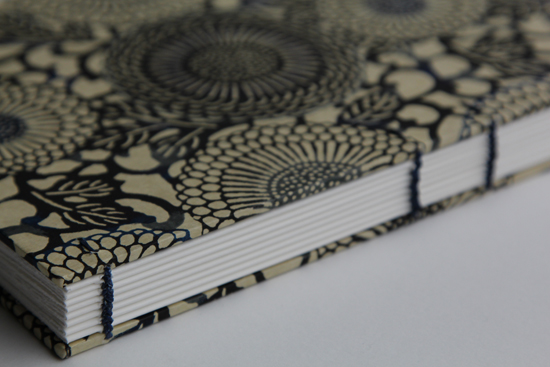
Two-needle Coptic binding; 9-5/8″ high by 6-7/8″ wide, with 128 pages in 8 sections. The pages are Mohawk Superfine 100lb text weight in smooth soft white. The cover paper is Japanese Chiyogami paper, which is a mixture of kozo and sulphite. This particular paper is Chiyogami 130 from The Paper Place.
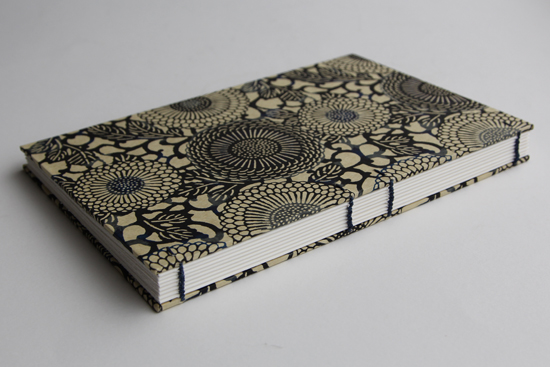
¶ Posted in
Paper | Tags:
bookbinding |
Comments Off on Blue Mums Coptic
Turquoise Grid Coptic
September 6th, 2012 | Link
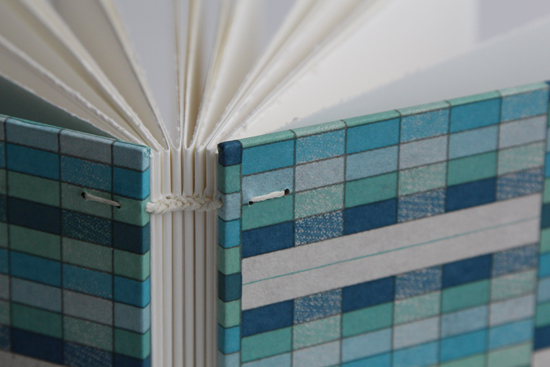
Two-needle Coptic binding; 9-5/8″ high by 6-7/8″ wide, with 128 pages in 8 sections. The pages are Mohawk Superfine 100lb text weight in smooth soft white. The cover paper is Japanese Chiyogami paper, which is a mixture of kozo and sulphite. This particular paper is Chiyogami 751 from The Paper Place.

¶ Posted in
Paper | Tags:
bookbinding |
Comments Off on Turquoise Grid Coptic
Blue Floral Coptic
September 5th, 2012 | Link
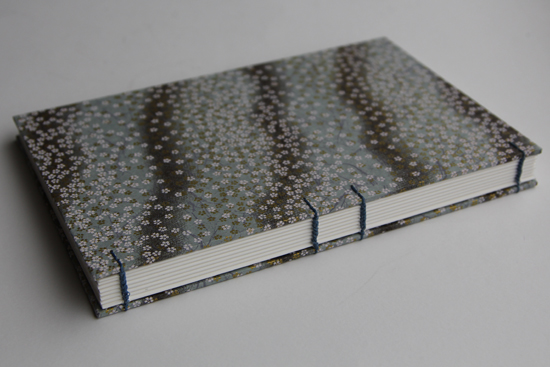
This is another paper I’ve used regularly over the years, a lovely muted blue-and-gray with tiny white blossoms scattered across it. It’s Chiyogami 439 from The Paper Place, and the books I’ve made with it are almost always among the first to be chosen when I sell them.

¶ Posted in
Paper | Tags:
bookbinding |
Comments Off on Blue Floral Coptic
Black Mountain Coptic
September 4th, 2012 | Link

As mentioned before, this is one of my favourite papers, Chiyogami 30 from The Paper Place. I mentioned to a Japanese coworker of E’s that this is one of my “man-papers” as it has more masculine feel than most of the Chiyogami papers I regularly use. He laughed at me, and said that in Japan it wouldn’t be considered masculine at all. (Sorry, Grant!)
For most of the Coptics I used the same paper on the inside cover as the outside, but for this one I used Chiyogami 213, a swirly, filigree-ish gold-on-white paper that seemed complementary.
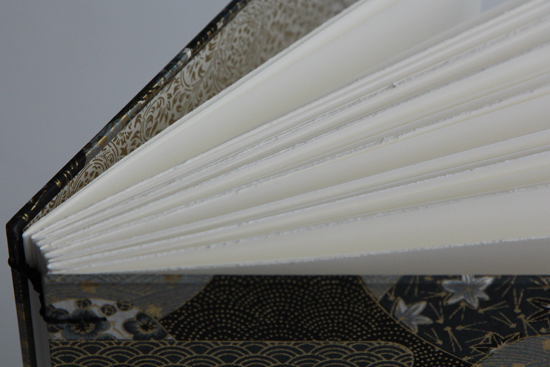
I switched back and forth between two different types of board attachments in this series of Coptics; what Keith Smith in Exposed Spine Sewings calls the “Type 3 Board Attachment”, which hinges through the board, and the “Type 2 Board Attachment,” which also has two holes in the cover but wraps around the spine instead of entering and existing through the side of the board. The main reason was that some of the thread I was using — like the black thread used on this book — was too thick to go through the side of the board without causing it to swell (or worse, tear).

¶ Posted in
Paper | Tags:
bookbinding |
Comments Off on Black Mountain Coptic
Barnyard Coptic
September 3rd, 2012 | Link
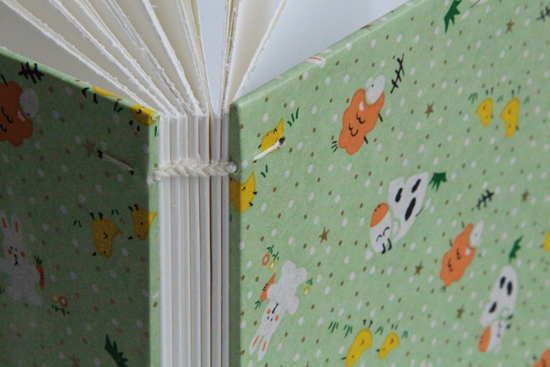
I hereby dub this month “Coptic Month” on bathtubdreamer, because we had very nice lighting the other morning and a new camera, so I needed something to take pictures of. And here we are.
The Coptic binding is one of the first bindings I learned, when I took a few classes through the extension program at the Alberta College of Art + Design. This type of binding dates back to as early as 200 AD in early Egypt (Wikipedia). It’s also known as a chain stitch binding, because of the appearance of the stitches on the spine.
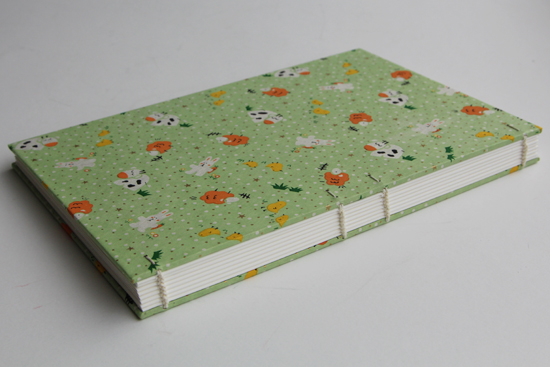
This particular version is called a two-needle Coptic, because it’s sewn with a needle on each end of the thread. There are actually two threads: one for the two left chains, and one for the two right chains. I prefer the two-needle version over the single-needle version because the single-needle version has sad looking not-quite-chains on the stitches closest to the edges. Both types (and many others) are described in the third volume of Keith Smith’s Non-Adhesive Binding series, Exposed Spine Sewings.
There are a number of ways to attach the boards to the sections; Keith Smith calls this the “Type 3 Board Attachment” and it’s the way I first learned to do it. Since the thread comes through the edge of the board, rather than wrapping around, it hinges better than other attachments that wrap around. But it requires thick bookboard (I used .098″ Davey board), and even then I managed to tear the board on one of the books. But not this one.
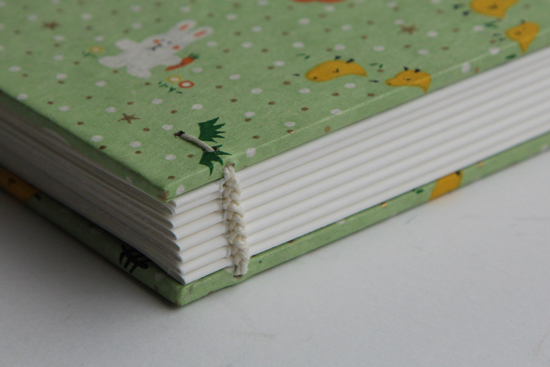
The finished book is 9-5/8″ high by 6-7/8″ wide, and there are 128 pages in 8 sections. The pages are Mohawk Superfine 100lb text weight in smooth soft white. The cover paper is Japanese Chiyogami paper, which is a mixture of kozo and sulphite. I buy most of my Chiyogami online from The Paper Place — this particular print is Chiyogami 280, and also comes in blue or red.
¶ Posted in
Paper | Tags:
bookbinding |
Comments Off on Barnyard Coptic
New Coptics
September 1st, 2012 | Link
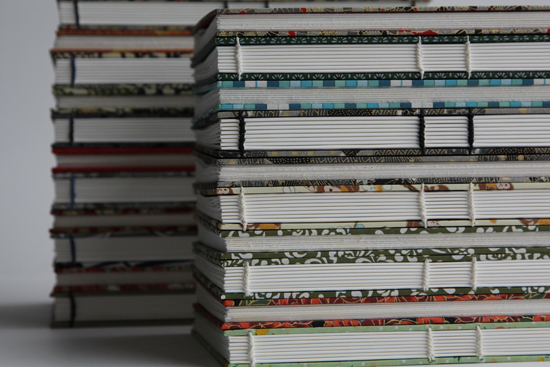
Part of this summer’s Discardia project was to re-evaluate the things I do for fun — like bookbinding. Another part was to catch up on all the business reading I’ve been meaning to get through, and I finished several books that I’d had queued up for months (or longer). One of those was Mihaly Csikszentmihalyi’s book Flow: The Psychology of Optimal Experience (here’s the short version in Csikszentmihalyi’s TED talk).
I haven’t been doing as much bookbinding in the last couple of years. Part of the reason is that changing roles last year cut down a bit on my free time, as I tried to wrap my head around my new areas of responsibility. Part of the reason, I think, is that I have hit this awkward stage in my binding in which my skills have leveled up to the challenges of the bindings I usually do. I’m still pleased the final product but some of the creation parts aren’t as enjoyable as they used to be; they’re not triggering what Csikszentmihalyi calls the “flow” state the way they used to do.
Work was fairly stressful this summer, and on a couple of weekends when I had energy I did all the prep work for the Coptics above, making all the covers and punching holes in the sections. Then when I got home in the evenings and my head was still too wrapped around work for me to focus, I could stitch together a book or two. There’s still something satisfying about doing the stitching, trying to get the tension exactly perfect and watching the book finally come together, that helps calm my wild mind on nights like that.
¶ Posted in
Paper | Tags:
bookbinding |
Comments Off on New Coptics
Don’t Panic!
June 21st, 2012 | Link

I broke out my Gocco and printed these Moleskine notebooks for everyone on my team at work. I don’t think they all get the Douglas Adams nod, but they appreciated the humor.
¶ Posted in
Paper | Tags:
gocco |
2 Comments »
Making Books with My Nephews
December 3rd, 2011 | Link
I go back to Calgary a couple of times a year. Whenever I visit we have a family dinner, which, between my parents and five siblings and assorted spouses and seven nieces and nephews (five of whom are 10 years old or under), tends to be a chaotic event with lots of catching up to do.
Last weekend the event was at my brother’s place, and I got to spend a little time with my nephews before everyone else arrived. The six-year-old, Reece, was in the playroom drawing, and I asked him if he wanted me to make him a book. He got really excited and gathered a handful of large index cards for me, and tape, and scissors. When I told him I was only going to use one piece of paper and no tape and he was pretty skeptical.
(I have to be honest here: the day before I flew up to Calgary I quickly learned a few single-sheet structures, just in case I got a chance to do this. The pamphlet Books from a Single Sheet of Paper from the web site Bookmaking with Kids has a half-dozen simple structures — including those I used.)
I started out with a book that the BWK pamphlet calls a center cut accordion. Reece wasn’t interested in making the actual book (when it was done he asked me to write “Rudolph the Red-Nosed Reindeer” on the cover and then he handed me another piece of paper and asked me to make one for “Cars”), but while I was working on it his eight-year-old brother Will asked me to show him how to make one. He had a little trouble matching the corners up but it turned out just fine.
Reece wanted another book, so I asked if I should make a “pants book” (dubbed the long cut accordion in the BWK pamphlet — it looks like a pair of pants when unfolded). This got both boys giggling and they thought definitely I should make a pants book. So I made that, and then a simple accordion, and then an accordion with pockets so Reece could put things in the pockets, and then another pocket accordion shaped like a row of houses — so we made paper dolls to put in the house pockets. The dolls had abnormally enormous heads, so Will and I dubbed them Brainiacs.
It was half an hour. I think they had fun. They’re old enough now to remember me when they see me, so I think it would be cool if they remembered me as the auntie that made books.
¶ Posted in
Paper | Tags:
bookbinding |
Comments Off on Making Books with My Nephews
Woven Chain Albums
November 6th, 2011 | Link

This has to be one of the most elegant exposed stitch bindings around: it’s the Woven Chain sewing from the second volume of Keith Smith’s non-adhesive binding series, 1- 2- & 3-Section Sewings. I used it some time back for Jane and Patrick’s wedding guest book, of which the baby-themed album above is pretty much an exact copy, aside from the paper.

The baby album and Jane and Patrick’s guest book both have three sections of Rives BFK cover-weight paper totaling 24 pages. The black album above has only two sections, so there’s only one line of chain to link the sections together. I think this album, with the elegant paper and slubbed, silky bookcloth, suits the elaborate nature of the stitching better than the matte bookcloth and bunnies in the baby album. But both are nice.
¶ Posted in
Paper | Tags:
bookbinding |
Comments Off on Woven Chain Albums
Long Stitch Journals
October 26th, 2011 | Link
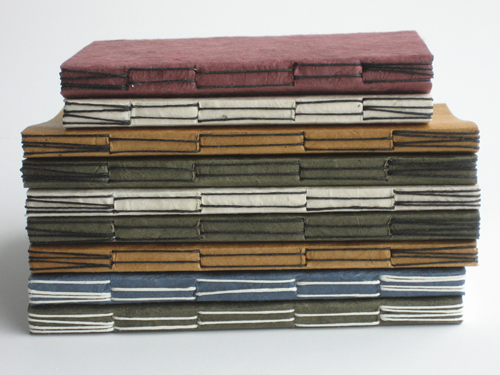
I love non-adhesive long stitch bindings when I feel like making something but I don’t feel like dealing with all the mess and time involved in making hard cases. Look ma! No glue!
These are an old standby from Keith Smith’s Non-Adhesive Binding I: Books Without Paste or Glue. Each one has approximately 64 pages of Mohawk Superfine paper; the weights and sizes vary because I was experimenting with folding down large sheets and using up whatever was lying around the studio, but the largest are about 4″ by 6″. The covers are Lokta Bark paper purchased from Hollanders.
¶ Posted in
Paper | Tags:
bookbinding |
Comments Off on Long Stitch Journals





















